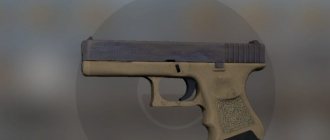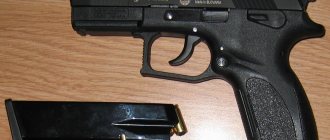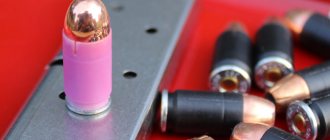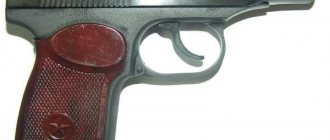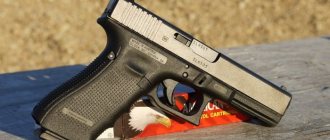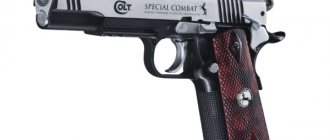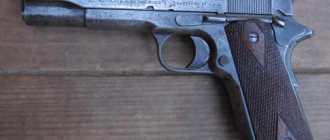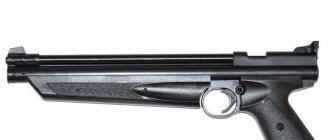Home | Weapons | Pistols | Austria | Glock 17
Third generation Glock 17 pistol
Fourth generation Glock 17 Gen 4 pistol
The Austrian Glock 17 is currently one of the most popular and recognizable self-loading pistols, in constant high demand both among police and armed forces around the world, and among ordinary citizens buying weapons for sport shooting and self-defense. Many experts in the field of personal weapons and their combat use consider Glock pistols to be the best in the world due to the excellent combination of such qualities as reliability in the most difficult operating conditions, accuracy more than sufficient for combat shooting and self-defense, both aimed and high-speed “instinctive” shooting offhand, high safety, convenience, comfort during constant concealed or open carry, maximum ease of use, ease of maintenance, enormous service life, interchangeability of parts, very high strength and resistance of the coating of steel parts to corrosion and wear, and finally, comparatively low cost.
Update: in 2017-2018, the manufacturer released the fifth generation of pistols. More about Glock 17 Gen5
This weapon is preferred by professionals participating in combat and special operations, and by fighters of the best special forces in the world. People living in countries where personal handguns are legal for sale to civilians are guided by the same principles when choosing a Glock for shooting practice or for carrying for self-defense as military and police officers. It's always better to own a gun that won't let you down on the range or on the street. It is better to have a weapon that is convenient and easy to use than one that is difficult to handle, which is especially important for those who do not have the opportunity to regularly train with their pistol on the use of weapons in extreme situations. It is no secret that owners, in conditions where there is simply no time to think, and all actions are performed automatically, sometimes simply forget whether the safety on their pistol is on or not, and often about its location. Of course, this is not a problem for a trained professional, but for the average person who is not used to often having to deal with extreme situations, ease of handling of his pistol is vitally important.
Today on the arms market around the world there are a lot of easy-to-handle models from large and well-known manufacturers that have earned a good reputation. Compliance with this requirement is achieved primarily by the presence of only a self-cocking firing mechanism and the absence of a manually controlled safety lever, or the pistol is equipped with a double-action trigger with a lever for safely decocking the hammer and, again, without a safety lever. There are, of course, a lot of options. But the choice of police, military and civilians is dictated not only by ease of use, but also by the presence of the other advantages stated above in Glock pistols, which make these weapons practical and suitable for any task.
Shooters participating in practical shooting competitions in IPSC, in the class of mass-produced weapons, also often prefer the simple, accurate, reliable and convenient Glock 17 to more expensive pistols. Of course, the design features of its trigger and the need to ensure safety in handling require a fairly large force and travel length of the trigger, which are generally quite acceptable, but nevertheless negatively affect the accuracy of aimed shooting, say, at a distance of 14 meters, in comparison with pistols equipped with a double or single action trigger. However, not to mention the advantages in a combat situation over such classic designs, it should be noted that Glock pistols consistently demonstrate quite good accuracy for a combat pistol with a wide variety of shooter stances and methods of holding the weapon. In addition, its accuracy is quite sufficient even for those who like targeted shooting from serial pistols and achieving maximum results. With a new, just purchased Glock pistol, you can immediately go to the shooting range and it will shoot accurately.
However, controversy continues over the design of these popular Austrian pistols. Let's just say that most of the self-loading pistols on the weapons market today are more visually pleasing than the monotonous Glocks with a strictly functional and, so to speak, ascetic design. Although many people like strict forms more than elegant models. But this is a matter of taste. This controversy continues in the gun press, shooting clubs and on Internet forums. Moreover, shooters and gun lovers are mostly divided into those for whom Glock is the best pistol in the world, and those who hold the opposite opinion, or argue in favor of other manufacturers and their models that are superior to Glock in certain qualities.
Sometimes those who prefer the Glock 17 choose another weapon as their main pistol, and opponents of these Austrian pistols become their ardent supporters. At the very beginning of their introduction to the market, there were many legends about the pistols of this company that these weapons could not be recognized by detectors at airports. Of course, this was pure fiction, exaggerated by incompetent journalists. There are more than enough metal parts in the gun to detect it. However, Gaston Glock had to personally demonstrate publicly the “visibility” of his company’s pistol detectors, as a result of which the myth was dispelled. In any case, the Glock company has achieved enormous success, supplying gun markets in various countries around the world with its products. And those who have tried these pistols in shooting, even if they do not have a particularly positive attitude towards their design, choose Glock for use as their main, one of the main or backup weapons.
Glock was created in 1980 by a group of designers with the participation of Friedrich Dechant under the leadership of Gaston Glock at an Austrian company founded in 1963 that had never before been involved in the design and manufacture of weapons. At first, the company specialized in the manufacture of tools, then began producing military goods - machine gun belts, grenades and knives. By the way, the company still produces high-quality knives. And Gaston Glock was prompted to produce pistols by the Austrian army’s search for new personal weapons in 1980. The designers managed to implement revolutionary solutions at that time, which, as practice has shown, work great in combat pistols. The result was one of the company's leading positions in the global arms market and the widest popularity of its products. The Glock 17 is the first pistol with a plastic frame and has earned great success in the global gun market. The frame, trigger and magazine are made of high-strength polymer.
For the first time, the pistol combined light weight, large magazine capacity, compactness and safety in use when carried with a cartridge in the chamber. The Austrians borrowed the barrel locking mechanism from the Sig Sauer P220 pistol. The designers abandoned the manually controlled flag fuse in favor of automatic ones. The trigger mechanism was the simplest, created on the basis of the Austrian Roth-Steyr M1907 pistol. It should be clarified that index 17 does not indicate the number of cartridges in the magazine. This is Gaston Glock's patent number. In 1982, under the designation P-90, the pistol was adopted by the Austrian army and police. The Glock 17 was equipped with the anti-terrorist unit of the Austrian Federal Police EKO Cobra (Einsatzkommando Cobra).
Later, the Glock 17 pistol began to be used by the armed forces, law enforcement agencies and special forces of Sweden and Finland, and since 1986 it was adopted by the Norwegian army. Since the start of production of the first Glock model, there have already been three generations of these pistols, and the fourth generation is currently in production - Gen 4. The first generation did not have a notch on the front and rear surfaces of the handle, which appeared on the second, which began production in 1990. The third generation, in addition to notches and chaotic corrugation on the sides of the handle, also received recesses for fingers on the front surface of the handle and recesses with a lower protrusion for the thumb, both in the left and right surfaces of the handle, as well as guides in the front part of the frame for fastening of additional devices.
In the late 1990s, the Glock 17 replaced the Jericho 941 in YAMAM, a special unit of the Israeli police. After this, some special forces of the Israeli Defense Forces adopted it to replace the Sig Sauer P226 and Sig Sauer P228. Currently, Glock pistols are used in the armies and various security forces of about 60 countries. In 1986, Austrian pistols began to be imported to the United States. The first law enforcement agency to adopt Glock 17 pistols was the police department in Colby, Kansas, and the first large batch was delivered to the department in St. Paul, Minnesota. Noteworthy are the tests of Austrian pistols conducted by 25 police officers from Miami.
The weapon was tested for safety when dropped onto steel and concrete from a height of 18 meters with a cartridge in the chamber. There was no shot. The weapon was kept in salt water and a fully loaded magazine was fired at a high rate. There was not a single delay. It fired 1,000 rounds of hollow-point bullets continuously over 45 minutes without any problems. After these tests, the Miami Police Department adopted Glock 17 pistols. Currently, various versions of Glock personal short-barreled weapons are in service with the US FBI (models 22, 23 and 27), New York police (with the New-York Trigger trigger, which has a greater trigger force), police departments in Florida, Miami, Boston, the state police of Kansas and South Carolina (the South Carolina police first adopted the Glock 22 pistol) and Mississippi, the Customs Department and the Drug Enforcement Administration, as well as various special forces, for example the US Navy Seals and Delta. About 5,000 US federal and local police departments have adopted it.
Glock pistols make up a little more than half of all handguns purchased by US law enforcement agencies. They are used by police all over the world, for example, the Glock is in service in Canada, Holland, Mexico, Saudi Arabia, India and the Philippines. The Glock 17 is used by the Hong Kong Police Force. Iraqi police also use Glock pistols along with other short-barreled weapons, such as those made by Beretta and Sig Sauer. In Germany, the Glock 17 is in service with the famous Special Forces Unit of the German Federal Police GSG9 (Grenzschutzgruppe 9 - Border Security Group 9) and SEK - the special forces of the German police (Saxony-Anhalt Spezialeinsatzkommando). In France, the Glock 17, along with the 19 and 26 models, is in service with the National Gendarmerie Intervention Group GIGN (Groupe d'Intervention de la Gendarmerie Nationale), the anti-terrorism special unit "Search, Assistance, Intervention, Dissuade" RAID and the Investigation Group of the French National Police GIPN .
In Belgium, the Glock is used by the assault unit of the National Gendarmerie - ESI (Esquadron d'Intervention Special) and the BBT special unit of the Antwerp Police Department. Glock pistols are used by the Polish Mobile Rapid Response Team GROM (Grupa Reagowania Operacyjno-Manewrowego). The Glock 17 is used in law enforcement agencies and departments of the Russian Federation, along with other Western models, such as the CZ 75 B, and Russian ones - SPS, PYA, GSh-18, firing 9x19 cartridges. For example, these pistols are adopted by the FSB, GRU, FSO, Federal Penitentiary Service of the Russian Federation and special forces of the Ministry of Internal Affairs. The success of the pistol is also contributed to no small extent by the manufacturer’s extensive advertising campaign. But not only. In comparative tests, Glock always passed tests for reliability, ease of use and safety, and shooting accuracy. Glock is famous for its good service. All defective parts are easily replaced with new ones, and instead of the old coating with a worn outer black layer, a new one is applied for a nominal fee. At the moment, the manufacturer has sold more than 2,000,000 pistols of various modifications.
Why are Austrian Glock pistols so popular all over the world?
The incredible popularity of the Glock pistol is due to the fact that all the models produced by this Austrian company are highly reliable and unpretentious, which is quite a rarity among modern Western pistols. The Glock-17 pistol is considered the most popular and reliable, although other models are also quite reliable.
Many world experts in the field of weapons consider Glock pistols to be the best pistols in the world, as they have the following characteristics:
- Glock pistols are capable of working in the most difficult conditions;
- The excellent tactical and technical characteristics of these pistols ensure accuracy of both aimed and offhand shooting;
- The safety of Glock pistols is at the highest level due to the design features;
- Safety and comfort of wearing, both small models of pistols and full-size modifications;
- Ease of handling the weapon, including its maintenance;
- High service life of all Glock models;
- Wear resistance of all parts of the pistol. The coating of the steel parts of the gun perfectly resists corrosion;
- Quite low cost, although compared to domestic pistols this point is not very relevant.
Glock pistols are excellent military weapons of choice for professional special forces soldiers around the world. The ability to use this pistol with a silencer and the absence of problems during operation made it a favorite weapon for special operations and one of the most beloved among the civilian population of those countries where the carrying of short-barreled weapons is permitted. For those people who do not have the opportunity to frequently train with weapons, they need just such an easy-to-use pistol.
There are many different models of Glock pistols, which are intended for both military and police service, and for self-defense. The most popular models of Glock pistols are:
- "Glock-17", which brought glory to the Austrian, which has the ability to fire in bursts. This model was created on the basis of the Glock-17, specifically for the Austrian special forces Cobra;
- The Glock-19 pistol is a more compact model of the Glock-17 pistol. Features a shorter pistol grip and shorter bolt length;
- The Glock 26 pistol is one of the company’s most compact models. It is quite popular among women for self-defense and as a last-resort concealed weapon for various undercover agents.
The popularity of Glock pistols is evidenced by the fact that more than 50 percent of all pistols sold in the United States are Glocks. Pistols from this company are distinguished by stable accuracy, and you don’t even need to shoot them. By purchasing a Glock pistol, you can be sure that it will shoot accurately on target.
Although the performance characteristics of Glock pistols satisfy even the most demanding critics, controversy still rages about its appearance. The design of Glock pistols is quite interesting, although monotonous. Many modern pistols look more attractive than the ascetic Glocks, the design of which is strictly functional and has only one goal - to make the pistol simple and easy to use.
The Glock pistol does not have a safety lock, and it can be fired immediately after being snatched. At the same time, it is extremely safe, since the shot will only fire when the trigger is fully pressed. Most people who have been able to try Glocks in action usually immediately choose these pistols as their main or backup weapon.
Modifications
The Glock 17 pistol has become the basis of the range of pistols, modifications of which are produced by the Glock company. Currently, there are the following modifications of the Glock 17 pistol:
- The Glock 17L is a long-barrel variant of the Motivated model, which was introduced in 1988.
- Glock 17C is a modification that is armed with a compensator cut into the casing and barrel.
- The Glock 17R is a variant with a reddish plastic case without training cartridges. Allows you to use training/laser ammo.
- Glock 17T - shoots paint markers.
- Glock 18\18C is a modification that is adapted for burst fire.
- Glock 19\19C is a small-sized version with a shortened barrel – only 102 mm.
- Glock 20\20C - modification chambered for 10 mm Auto, includes an integrated compensator and has a magazine for 15 rounds.
- Glock 21\21C is a variant chambered for .45 ACP. The barrel profile has been changed, the magazine capacity has been reduced to 13 rounds.
- Glock 22\22C - variant chambered for .40 S&W. In 1997, the FBI adopted this model as a service weapon.
- Glock 23\23C is a shortened model of Glock 22.
- Glock 24\24C is a modification of the Glock 22 with increased accuracy of fire and an extended barrel.
- Glock 25 is a modification chambered for .380 ACP.
- The Glock 26 is a subcompact version of the Glock 17.
- Glock 27 is a modification chambered for the .40 S&W cartridge.
- The Glock 28 is a compact variant of the Glock 17.
- Glock 30\30S is a small-sized modification of the Glock 21.
- Glock 31\31C is a variant chambered for .357 SIG.
- The Glock 37 is a variant chambered in .45 GAP.
The creation of the Glock-17 pistol
The first Glock-17 pistol was manufactured in 1980. , which was founded in 1963, decided to develop a model of its pistol. The company was prompted to take this step by a competition in which a new pistol was selected for the Austrian army. To manufacture this weapon, a group of designers, under the leadership of Gaston Glock, developed drawings of a new pistol. The design of the first Glock was quite unusual - it was the world's first pistol in which the frame, trigger and even the magazine were made of polymer that could withstand heavy loads and temperatures. If rumors are to be believed, Gaston Glock began developing his pistol back in the mid-1970s.
Due to the use of a large amount of plastic polymer, the Glock pistol managed to combine many previously incompatible parameters:
- Light weight, with fairly impressive dimensions;
- Large magazine capacity;
- Safety of use. A Glock -17 pistol can fall from a height of 2 meters onto an iron plate, and a spontaneous shot will not occur.
The barrel locking system was copied from the Sig Sauer P220 pistol. The trigger mechanism was of a simple design, which was copied from another Austrian pistol - the Roth-Steyr M1907. The number 17 in the name of the Glock pistol was not chosen by chance and does not mean the number of cartridges that fit in the magazine, but the number of the patent that was received by Gaston Glock. In 1982, the Glock-17 pistol was adopted by the Austrian police and army.
After some time, the Glock-17 pistol began to be used not only by the Austrian military, but also by special and law enforcement units in Finland and Sweden. The Norwegian Army adopted the Glock-17 in 1986.
The Glock-17 pistol is still in production. Over the years, the Glock pistol has undergone several upgrades. Now the 4th generation of Glock-17 is being produced, which is designated as “Gen 4”. The second generation pistol received a notch on the back and front, which the first generation lacked. This modernization, which began production in 1990, has become more secure in the hand.
The third generation of the Glock pistol received anatomical notches on the front of the handle, as well as notches for the thumbs, which were available on both the right and left. In addition, various additional devices can be attached to the Glock-17 pistol, for which mounting is provided in the front part of the frame.
At the end of the 90s of the 20th century, the Glock-17 pistol entered service with the special forces of the Israeli police. Having seen how effective the Glock pistol was, many units of the Israeli army adopted it into service instead of the Sig Sauer pistols of the P226 and P228 series.
Once Glock pistols began being exported to the United States, they quickly gained popularity. At first, the American police were armed with them, then FBI agents began to use compact Glock pistols. Unlike police officers, FBI employees preferred to use compact models of Glock pistols.
The main performance characteristics of the Glock pistol are as follows:
- Pistol caliber 9mm Parabellum;
- The length of the weapon is 186 mm, with 114 mm per barrel;
- The weight of the pistol without cartridges is 625 g, with cartridges - 905 g;
- The standard magazine holds 17 rounds, although there are options for 10, 19 and 33 rounds.
Updated fifth generation Glock 26 subcompact
In 2022, a new modification of the fifth-generation subcompact model was presented to the general public. Changes included the coating of the external surfaces of the case, the installation of an ambidextrous bolt stop lever, and the replacement of the base barrel with a Marksman Barell version (carried over from the sports model). In addition, changes were made to the handle - as on all fifth-generation Glock models, the finger grooves disappeared, and the neck of the shaft was increased in size. The magazine itself has also undergone changes - it has been modified to reduce delays in the supply of ammunition.
Operating principles of the Glock pistol
The automatic operation of Glock pistols works on the principle of using recoil during a short stroke of the pistol barrel. The barrel is locked using the breech of the barrel, which enters the cartridge ejection window with its rectangular protrusion. The trigger mechanism in this pistol is striker-type; it is pre-cocked due to the release of the pistol bolt. The final cocking occurs when the trigger is pressed. Although it calls the pistols of its design self-cocking, in fact this system is a classic single-action trigger mechanism. The additional cocking of the striker is only a successful development that complements the classic trigger without changing its essence.
Although the pistol does not have a safety lever, the length and force of the stroke prevent an accidental shot. The safety of Glock pistols is due to the presence of three independent fuses. This system is called “Safe Action”.
The following devices are used as standard sights on the Glock pistol:
- A rear sight that can move horizontally;
- Front sights with the possibility of vertical adjustment.
All sights are made of plastic, which makes the gun lighter, which is already quite light for its size.
Sights and other devices
The Glock gun has sights made of plastic, installed in transverse dovetail grooves, and they are removable. For ease of aiming in low light, there is a luminous dot on the front sight, as well as a luminous frame on the rear sight. The rear sight may be adjustable, but military models do not include them. Since 1988, a pistol of this model is almost always equipped with a special guide for attaching a tactical flashlight or laser target designator (LTS).
The gun can also be equipped with a silencer. Equipped with a suppressor, the Glock turns into a pretty tough weapon when it comes to quiet operation and fire density. Only the most elite units own this hidden modification of this pistol.
Opportunities for tuning Glock pistols
Currently, there are many companies that manufacture many so-called “spare parts” for tuning firearms. Naturally, for such a popular pistol as the Glock, many different parts and devices are made that help when shooting.
Most often, the following accessories are purchased for Glocks:
- Enlarged magazine latches that prevent the magazine from spontaneously falling out. Sometimes the magazine is removed from the holster and falls out when the gun is removed. Using an enlarged magazine latch allows you to forget about this problem forever;
- The return spring is often replaced, although this replacement is only relevant when using reinforced cartridges. Otherwise, a powerful spring will lead to delays in shots, since the shutter-casing will not open completely;
- Plastic flies are often replaced with steel ones;
- Standard rear sights are also often replaced with more advanced models.
Tuning a Glock pistol is only appropriate when the weapon is used for sport shooting. In this case, the weapon must have ideal settings. For standard combat missions or self-defense, a standard Glock is quite sufficient.
Technical characteristics of the Glock 26 gen5 pistol (all generations of the 26th)
| Characteristics | Glock 26 gen 4 | Glock 26 gen 5 |
| Caliber, mm | 9x19 mm NATO | 9×19mm NATO |
| Weapon length, mm | 160 | 160 |
| Barrel length, mm | 88 | 88 |
| Weapon height, mm | 106 | 106 |
| Weapon width, mm | 33 | 33 |
| Gun weight, kg | 0,56 | 0,56 |
| Trigger force, kg | 2,5 | 2,6 |
| Magazine capacity, cartridges | 10 (12/15/17/19/24/31/35) | 10 (12/15/17/19/24/31/35) |
Disadvantages of Glock pistols
Like any, even the most advanced weapon model, the Glock pistol has its drawbacks:
- If you don't pay enough attention to thoroughly cleaning your gun, your Glock pistol can often misfire. Their main cause is the ingress of dirt and sand into the firing pin channel. This problem can be avoided by cleaning your weapon regularly;
- If you hold the gun with an insufficiently strong grip, sometimes the cartridge may be under-fired or distorted;
- Plastic front sights, which were supposed to be reliable, turned out to be not strong enough in practice. They are easily knocked down when accidentally hit from behind. This problem is eliminated by installing a steel front sight;
- The shutter stop is not large enough. Replacing it with a larger delay eliminates this problem;
- The standard magazine latch sometimes leads to spontaneous ejection of the magazine with cartridges. This can also be treated by replacing it with an improved large latch.
The plastic parts of the pistol are quite reliable if you use cartridges recommended by the manufacturer. If more powerful cartridges are used (especially those loaded by hand), the pistol begins to break down, the plastic becomes covered with cracks, which eventually lead to their destruction.
An interesting feature of the Glock pistol is the ability to use it underwater at a depth of up to 3 meters. You can also shoot from under water, and the sound of the shot cannot be heard. Such shooting is often taught to special forces soldiers.
When using standard cartridges, the life of the Glock pistol is amazing. Although it is guaranteed to last 40,000 rounds, testing has shown that the average Glock 17 pistol can withstand about 350,000 rounds. At the same time, the main parts of the pistol remain in working condition.
The many skeptics who believe that a plastic pistol cannot be good can be countered by global statistics according to which Glock pistols are widely used by military and civilians around the world.
Glock tests under different conditions
It is necessary to mention the series of tests that the production Glock 17 successfully passed.
- Ice: The pistol with loaded magazine was frozen in an ice cube for 60 days. After that, he was removed from the ice and 100 shots of 10 rounds were fired.
- Mud: The gun was lubricated, closed and immersed in mud of various consistencies: dry sand, clay, wet river sand. After each such procedure, repeated 5 times, 100 shots were fired.
- Mud: The gun was completely wetted with water and immersed in river mud. After shaking the gun once with the remaining sludge, 10 series of 10 shots were fired.
- Water: The fully loaded pistol was immersed in water to a depth of 1 meter for 1 hour, then the pistol was removed from the water and 10 series of 10 shots were immediately fired.
Durability: A loaded pistol was placed on coarse gravel and then driven over by a heavy truck. The truck was then left parked with its wheel on the gun for an hour. After this, 100 shots were fired. All tests were carried out in the specified sequence with the same pistol and one magazine. There were no delays in any of them.
Every Glock pistol is tested by firing high power test cartridges that create high pressure in the bore. Practice has confirmed that Glock can withstand almost twice the pressure. The weapon has a large durability resource. Some pistols remained functional after hundreds of thousands of rounds.
The practice of regular shooting by the owners of these pistols over a long period of time, as well as shooting underwater and long-term shooting without cleaning and lubricating the weapon, confirms the highest resistance to corrosion of all parts - Glock does not rust. As for survivability and service life, the products of the Austrian company set simply amazing records. The pistol's warranty life is 40,000 shots, but factory tests have shown that the Glock 17 can withstand more than 360,000 shots without mechanical failure of the main parts of the weapon.
Chuck Taylor, a weapons expert and renowned journalist, has already fired more than one million rounds of ammunition from his Glock! Overall, Glock pistols are very practical, excellent weapons in all respects, and are the best choice for both police, military and special forces soldiers, as well as for ordinary citizens who use a pistol for self-defense or who are interested in sports shooting.
At the end of 2009, the company began producing the fourth generation of Glock pistols, designated Gen 4, which were presented at the 2010 SHOT Show in Las Vegas. The first Gen 4 models were the fourth generation Glock 22 and Glock 17 pistols, designated Glock 22 Gen 4 and 17 Gen 4, respectively. The main innovations of Gen 4 were: replaceable panels on the back of the handle; new handle surface texture; two return springs; narrower handle; an enlarged magazine release with a larger contact area that can be moved to the right side of the pistol frame; On the left side of the bolt housing, behind the stylized company logo and model number, there is the designation Gen 4.


